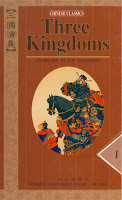 The third
example I would like to share with you is the historical novel Three Kingdoms, written in the tradition
of the Spring and Autumn Annals which are attributed to Confucius. The
historical novel of the Three Kingdoms is so important because it describes
The third
example I would like to share with you is the historical novel Three Kingdoms, written in the tradition
of the Spring and Autumn Annals which are attributed to Confucius. The
historical novel of the Three Kingdoms is so important because it describes
While
‘preserving moral judgment’ in every turn of phrase the novel marks the ‘rise
and fall of kingdoms’ in a grand sweep of time. The novel has added to this
tradition by reaching the broadest possible public with its message. This
challenges a reader to reflect on how his own conduct measures up to the
standards of loyalty and filial piety as they are fulfilled or betrayed in the
novel. As Jiang Daqi said in the preface to the novel ‘merely to read it but
not apply [its lessons] vigorously in one’s own life, is inferior to [real]
study.’














